On military academies around the world the battle of Bodange is used as an example of how the actions of a friendly unit can create more problems then that of the enemy, so called "friction" between units.
Let me start to tell about the battle of Bodange with explaining the Belgian army's plan of defence for the Ardennes region; by 1940 the Belgian army has given up the idea of trying to defend the entire country as a result of this the Ardennes region will only be guarded by small units of mobile infantry and cavalry units, in the event German units attack Belgium their task is to blow up the bridges and roads in their sector, to activate minefields and so on.
After these destructive actions are completed these individual units should retreat towards the main line of defence of the Belgian army the so called KW line in the centre of the country, to allow the most southern units to retreat the northern units will have to fight small defensive battles with German recon troops; but according to the plan none of the units should be engaged in a prolonged battle against the German invaders.
Because of Belgium's neutrality this plan, not to defend the Ardennes region, can't be officially told to the allies but in secret the French army has been informed; not really glad with the intentions of the Belgian army in this sector they nevertheless have to deal with it; in case of an invasion, the French will sent in light cavalry troops in to the Ardennes to engage the German recon troops that are expected to infiltrate there.
The German plan for the Ardennes is of a much bigger scale, no small operations with recon troops but an advance through this region of no less then 7 of there 10 available Panzer Divisions!
The German planners of course also have their intelligence and they are aware that only small numbers of Belgian troops are present in the Ardennes, what worries them more then the amount of enemy troops in the region are the defensive obstacles on the few roads that can carry their heavy tanks.
Because of the time it will take to advance through Luxemburg a surprise attack on the Belgian army is impossible here; to counter this problem the German advance guard for the first days will not be made up of armoured forces but mobile infantry, they will be able to move swiftly through the obstacles, knock out the Belgian or French defenders with their superior numbers and fire power and thus give the engineers the necessary time to clean up the damage done by the Belgian armies destructive operations so that their tanks can follow up closely behind them.
Against the advice of Guderian the German army also orders a small airborne operation behind the Belgian pockets of defence on the roads from Martelange and Bastogne to Neufchateau, the roads used by the first and second Panzer divisons; a battalion of Regiment Großdeutschland will land in Fiesler Storch planes, with the task to hold the road open and to disrupt the Belgian lines of communication.
Alas for Guderian they succeed in their task!
Bodange itself is a very small village in the deep Sure river valley, its topography makes this village the ideal place to block the road from Martelange (Belgian/Luxemburg border) to Neufchateau; the defensive set up in this sub sector is in two parts, the first line of defence is on the border between Luxemburg and Belgium in the town of Martelange, on May 10 1940 this town is guarded by troops of the 4th company of the First Regiment Chasseur Ardennais.
Around 06.00 the Germans reach the Belgian/Luxemburg border, the bridges are blown up according to plan, now Schützen Rgt 1 attacks in full force, just before 11.00 the defenders give up their resistance and start there retreat, a bit later they bypass their comrades in Bodange in the second line of defence and at noon they have retreated completely according to plan to the battalion assembly area.
In the meanwhile in Bodange commander Bricart of the 5th company of the first Regiment Chasseur Ardennais has +/- 80 men at his disposal on the morning of May 10 1940 to guard the entire Sure valley in Bodange; once it is clear Belgium is once against at war with Germany, Cmdt Bricart starts to organize his defensive operation: road blocks are created and the bridge is prepared for destruction, he listens to advice given to him by his most senior NCO, a local inhabitant of the village, and he moves his small force that is used to protect the area around the bridge from the prepared positions (bunkers) in the valley to a line of five houses on the high ground opposite the river, from here they have a better view, have better concealment and they can better move around in their sector, thus using their limited forces more economically also the houses have very thick walls (+/- 1 metre thick rock stone walls) and thus give good protection to the soldiers.
Around 11.00 their comrades from the 4th company retreat across the bridge they are holding and after the last of them has crossed it, they blow it up.
The men of the 4th company tell Cmdt Bricart that they weren't facing a small recon force but a large and well equipped unit, they also ask him when he will retreat to the battalion fall back zone, Cmdt Bricart responds that he hasn't got the retreat order yet and that he will defend his position (as ordered that morning) until he gets the order to fall back to the battalion assembly area.
- Cmdt Bricart will never receive the retreat order; the airborne troops have cut the telephone line between his CP and that of the division/battalion and also around noon they will cut off the road so no motor- or bicycle ordnance can reach him anymore.
When the German troops reach Bodange they come under well aimed MG and rifle fire, to their surprise not from the bunkers from which they expect it but out of nowhere it seems.
The amount of casualties starts to rise rapidly and their frontal assault fails.
More troops need to be brought in, anti tank guns are aiming at the houses but their fire has no effect, not even their 75mm canon can destroy the houses.
Kradschützen Btl 1 is also directed towards Bodange to, they will have to dismount from their motorbikes and move as infantry through the forest just south of the little village, attacking the Belgian defenders in their flank but they have a very difficult time manoeuvring through the barbed wire fences of the pre war constructed defensive line.
Hours have past and the Belgians are still holding out!
For the Germans the situation is much worse then in Martelange hours earlier.
It is only in the late afternoon when four 88 canon are brought up that the Belgians can be driven from the fortified houses.
Now the flank attack also breaks through and the small Belgian force is split up; Cmdt Bricart is now isolated just West of the little village in another tiny hamlet, their he continues firing with his pistol from behind a rock on the Germans moving through the forest towards his men that hold out in the houses of Bodange; when he eventually tries to fall back with a handful of his men he is mowed down by MG fire from the opposite ridge and killed, soon afterwards what is left of his men can only surrender because they are completely surrounded and out gunned.
It is now 17.00 and the Belgian soldiers in the houses are running out of ammo and they cease fire for a moment to regroup and reorganize the little ammo that is left; the Germans that presume the cease fire is because the Belgians have given up come out of cover, the Belgians can't believe their luck and immediately open fire on these exposed German troops.
The Germans fall back again and remove their casualties under the cover of a white flag, which is allowed by the Belgian lieutenant, the platoon commander of men in the houses.
At 18.00 the resistance of the Belgian soldiers that are left is broken; when they eventually surrender the Germans are surprised that they only find 26 Belgian soldiers in the rubble of the houses!
Now the Germans use their POW's to clear up the minefields and their engineers can start to build an emergency bridge.
Only at 21.15 the first German vehicles start to cross the bridge in Bodange.
The German casualties for the battle of Bodange are estimated around a 100 KIA!
The Belgian losses are exactly known: 11 KIA and 18 WIA.
The irony of the entire event is that if the German airborne troops wouldn't have cut off the ways of communication between the CP in Bodange and the Battalion or Divisional HQ, Cmdt Bricart would have got the retreat order around 13.00 and the Germans would have been able to just march through Bodange unopposed and they would have had their emergency bridge up and ready hours earlier so that they could have reached the French/Belgian border defences on the afternoon of May 10 like in their original time table.
Now it is clear that because of the airborne landing the entire operation was delayed for 24 hours!
 2c7c7b29434e006d8bc8b1dce2fffbe1.jpg69.5 KB · Views: 27
2c7c7b29434e006d8bc8b1dce2fffbe1.jpg69.5 KB · Views: 27 5ab94ccabebc465c6d3e5e69897d3db9.jpg70 KB · Views: 31
5ab94ccabebc465c6d3e5e69897d3db9.jpg70 KB · Views: 31 5b03fa905126dce41d5d2eddb97adf27.jpg74.7 KB · Views: 45
5b03fa905126dce41d5d2eddb97adf27.jpg74.7 KB · Views: 45 06b2f6e1ed4ce274aa3ef911eb412a79.jpg73.1 KB · Views: 23
06b2f6e1ed4ce274aa3ef911eb412a79.jpg73.1 KB · Views: 23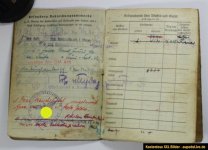 8ce432fd0f7a66b2867377e387ec1f47.jpg74.6 KB · Views: 29
8ce432fd0f7a66b2867377e387ec1f47.jpg74.6 KB · Views: 29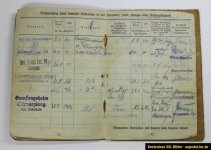 28f0f86b0da779c775bcb80d5859b0c9.jpg85.5 KB · Views: 19
28f0f86b0da779c775bcb80d5859b0c9.jpg85.5 KB · Views: 19 7119f0357e1b14264af92517faec5397.jpg85.2 KB · Views: 19
7119f0357e1b14264af92517faec5397.jpg85.2 KB · Views: 19 15408ce3106b3e5a3c33b63858a360dd.jpg76.7 KB · Views: 19
15408ce3106b3e5a3c33b63858a360dd.jpg76.7 KB · Views: 19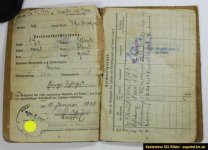 34842f64d93d85e5f7d5432413a7b8b4.jpg85 KB · Views: 18
34842f64d93d85e5f7d5432413a7b8b4.jpg85 KB · Views: 18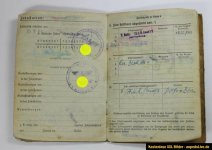 a21f00a46d88f027f17ef034e0c8d34e.jpg75 KB · Views: 21
a21f00a46d88f027f17ef034e0c8d34e.jpg75 KB · Views: 21













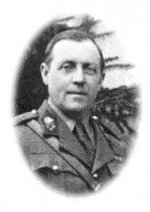
 Pretty interesting how Cmdt. Bricart used a GP.35 (presumably). Also, interesting is the weapon listed in the SB, looks like a "b" for Kar.b?
Pretty interesting how Cmdt. Bricart used a GP.35 (presumably). Also, interesting is the weapon listed in the SB, looks like a "b" for Kar.b?